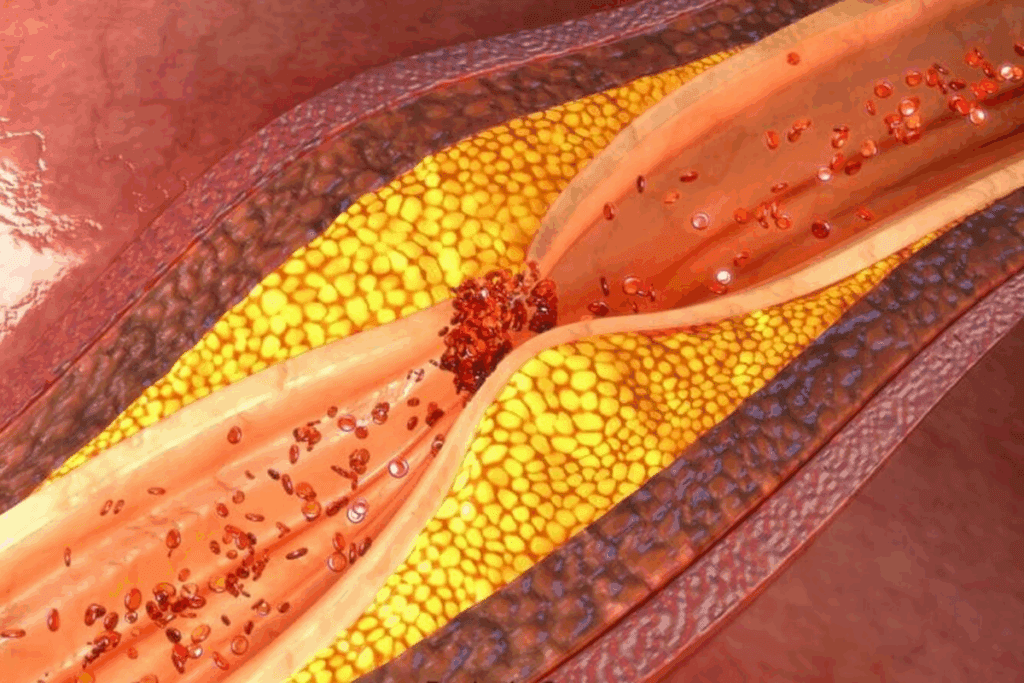Last Updated on November 26, 2025 by Bilal Hasdemir

At Liv Hospital, we know patients worry about heart stent procedures. The number of stents a person can have depends on their health needs and the disease’s complexity. How many stents can you have in your heart? Discover the surprising facts about the safety limits and risks of multiple stents.
Cardiac stents are tools to open arteries and ensure blood flow to the heart. The number of stents needed varies with each patient’s condition. We look at what affects the number of stents, including medical factors and individual differences.
Key Takeaways
- The number of stents a person can have depends on the complexity of their coronary artery disease.
- Cardiac stents help open arteries and improve blood flow to the heart.
- Individual medical needs play a significant role in determining the number of stents required.
- Our team at Liv Hospital provides personalized care and guidance throughout the stent procedure.
- Understanding the medical considerations behind stent placement is key for patient care.
Understanding Coronary Stents and Their Purpose

Coronary stents are key for those with heart issues. They help keep blood flowing well. These devices treat coronary artery disease, where arteries narrow or block.
What Are Heart Stents?
A heart stent is a small, metal mesh tube. It’s put in a narrowed or blocked artery to improve blood flow. Coronary stents keep the artery open, preventing it from narrowing again and lowering heart attack risk.
How Stents Work to Improve Blood Flow
Stents mechanically keep the artery open. This improves blood flow to the heart muscle. When a stent is placed, it expands against the blockage, widening the artery.
This not only restores blood flow but also reduces symptoms like chest pain (angina).
The process involves:
- Diagnosing the blockage using angiography
- Inserting a catheter with a balloon that is inflated to widen the artery
- Placing the stent to keep the artery open
Types of Cardiac Stents Available Today
There are many cardiac stents, each with its own benefits. The main types include:
| Type of Stent | Description | Benefits |
| Bare-metal stents | Made of metal mesh without any coating | Simple design, less expensive |
| Drug-eluting stents | Coated with medication that prevents cell growth | Reduced risk of restenosis |
| Bioresorbable stents | Made of materials that dissolve over time | Potential for improved long-term outcomes |
Knowing about these stents is vital for cardiologists and patients. It helps in choosing the best treatment.
How Many Stents Can You Have in Your Heart?

There’s no simple answer to how many heart stents are too many. The number depends on the person’s heart disease. It varies a lot.
This uncertainty can worry patients. But, the number of stents is decided carefully. It’s based on detailed medical checks and a treatment plan made just for you.
No Definitive Maximum Limit
There’s no fixed limit on the number of stents. The need for more stents depends on the heart disease’s severity. Some might need three, four, or even more stents.
The real focus is on the patient’s heart health, not just the number of stents. Our doctors look at each case closely. They consider many factors to find the best treatment.
Documented Range of Stent Numbers
Studies show a wide range of stent numbers. Some get one or two, while others get several. For example, having 5 stents in heart is seen in complex cases.
| Number of Stents | Clinical Scenario |
| 1-2 Stents | Simple to moderate coronary artery disease |
| 3-5 Stents | Complex coronary artery disease with multiple blockages |
| 6 or more Stents | Severe and extensive coronary artery disease |
Factors That Determine Stent Quantity
Several things affect how many stents a patient might need. These include:
- The extent and severity of coronary artery disease
- The presence of multiple blockages or complex lesions
- The patient’s overall heart health and medical history
- The effectiveness of previous stent placements or other treatments
Our team looks at these factors carefully. They decide on the best stent placement for each patient. While there’s no single answer, we focus on personalized care. We aim to meet each patient’s unique needs.
Common Scenarios: 2-3 Stents in Heart
Using 2-3 stents in heart procedures is common for complex coronary artery disease. Cardiologists often place more than one stent to ensure blood flow to the heart muscle.
We will look at when 2-3 stents are needed, what influences this choice, and what patients can expect from these treatments.
Clinical Situations Requiring 2 Heart Stents
There are several reasons why 2 heart stents are necessary:
- Multiple blockages: Patients with blockages in different parts of the coronary arteries might need two stents.
- Long lesions: A single long stent or two stents might be needed for extensive blockages.
- Bifurcation lesions: Two stents are often used to keep both arteries open at branching points.
When 3 Stents in Heart Are Necessary
Three stents are usually used in more complex cases, such as:
- Diffuse coronary disease: Patients with widespread disease might need multiple stents.
- Complex coronary anatomy: Three stents might be necessary for challenging anatomy, like tortuous vessels.
- Incomplete revascularization with fewer stents: Cardiologists might choose three stents to treat more disease.
Recovery and Outcomes with 2-3 Stents
Recovery for patients with 2-3 stents is similar to those with one stent, but with some extra steps:
- Monitoring: Patients with multiple stents need closer monitoring for complications.
- Medication regimen: Antiplatelet therapy is key to prevent stent thrombosis.
- Lifestyle modifications: Diet, exercise, and quitting smoking are more important for these patients.
When managed well, patients with 2-3 stents can see big improvements in symptoms and quality of life.
Complex Cases: 4-5 Stents in Heart
In complex cardiac cases, using multiple stents is key for effective treatment. Patients sometimes need more than one or two stents. This is because their coronary artery disease is severe or complex.
Medical Indications for 4 Stents in Heart
Patients might need 4 stents in their heart due to extensive coronary artery disease. This means they have blockages in many arteries or in the same artery. A detailed approach is needed to ensure enough blood flow to the heart muscle.
Deciding on 4 stents involves detailed tests like coronary angiography and fractional flow reserve (FFR) measurements. These tools help us understand the blockages and choose the best treatment.
Patients Requiring 5 Stents in Heart
Requiring 5 stents is rare but can happen in patients with very complex or widespread coronary artery disease. Such cases often involve long-segment disease or multiple lesions in key areas. This means we need to place multiple stents to ensure the best revascularization.
Handling these complex cases requires a team effort. Cardiologists, interventional cardiologists, and cardiac surgeons work together. They weigh the risks and benefits of multiple stent placements and create a treatment plan tailored to the patient.
Management Challenges with Multiple Stents
Managing patients with 4 or 5 stents is challenging. A big concern is the increased risk of restenosis or the narrowing of stented areas. Also, managing long-term antiplatelet therapy is harder because of the multiple stents. Patients need close monitoring to avoid bleeding or clotting risks.
Also, having multiple stents can make future heart procedures more complicated. We must plan and execute these procedures carefully to avoid problems with the existing stents.
Extreme Cases: Beyond 6 Stents in Your Heart
In cardiology, extreme cases challenge our understanding of medical limits. Most patients get a few stents. But some cases go beyond what’s normal. We look into these extraordinary situations to understand heart disease and its treatment better.
Can You Have 6 Stents in Your Heart?
It’s more common than you think to have 6 stents in your heart. Yes, it’s possible. But it depends on the disease’s severity, your health, and your heart’s anatomy.
Having 6 stents means your heart disease is complex. Cardiologists carefully decide on multiple stents. They weigh the benefits against risks after detailed imaging and assessment.
Documented Cases with 10+ Stents
There are cases where patients got more than 10 stents. For example, an Indonesian industrialist had nine implants for cardiac blockage. This shows the variability in stent placement.
These complex cases are managed by a team of cardiologists and surgeons. They plan and execute the treatment carefully.
The Extraordinary Case of 67 Stents
One patient received 67 stents, a truly extraordinary case. Such extreme cases are rare but show cardiology’s advanced capabilities and personalized treatment.
To understand better, let’s look at a comparison table. It shows typical stent cases and the extreme case with 67 stents.
| Category | Typical Cases | Extreme Cases |
| Number of Stents | 1-3 | 10+ |
| Disease Complexity | Moderate | Severe |
| Management Approach | Standard protocols | Multidisciplinary teams, customized treatment plans |
In conclusion, having 6 or more stents is rare but possible for some with complex heart disease. These cases highlight the need for personalized care and cardiology’s advancements.
How Many Stents Can Be Placed at One Time
Putting multiple stents in at once is common. But, how many depends on many factors and the patient’s needs. We’ll look at how to place multiple stents and what to consider.
Single-Session Multiple Stent Procedures
In some cases, you can get multiple stents in one go. This is often for patients with blockages in different or the same artery. The choice to do this depends on the blockage’s severity, location, and the patient’s health.
Getting multiple stents at once can be quicker and easier. But, it needs careful planning to avoid risks.
Staged Procedures for Multiple Stent Placement
Not everyone can get multiple stents in one go. Some might need staged procedures, where stents are put in over time. This lets doctors check how the first stent works and adjust as needed.
Staged procedures are good for complex cases or high-risk patients. They let doctors closely watch the patient and make changes if needed.
Factors Limiting Same-Day Stent Numbers
Several things can limit how many stents you can get in one session. These include your health, the disease’s complexity, and the procedure’s challenges. Also, the risk of complications like bleeding or stent thrombosis can affect the decision.
Our team looks at each patient’s situation and plans a treatment that balances benefits and risks.
Placement Strategies: How Many Stents Can Be Placed in One Artery
When placing stents in coronary arteries, doctors must think about a few key things. They need to decide how many stents can go in one artery safely. This choice is very important to make sure the stenting works well and doesn’t cause problems.
Technical Considerations for Multiple Stents in One Vessel
Putting multiple stents in one artery involves several technical aspects. The size and length of the stents, how bad the blockage is, and the artery’s shape are all important. Precise measurements and imaging techniques help figure out the right size and number of stents needed.
The table below summarizes key technical considerations for multiple stent placement in a single vessel:
| Technical Factor | Description | Importance |
| Stent Length and Diameter | Matching stent dimensions to the artery | High |
| Blockage Severity | Assessing the degree of arterial narrowing | High |
| Coronary Anatomy | Understanding the patient’s arterial structure | High |
Overlapping Stents: Benefits and Risks
Doctors sometimes use overlapping stents to cover a long blockage or lesion. This method can work well, but it also has increased risks like stent thrombosis and restenosis. It’s important to think about the benefits and risks of overlapping stents carefully.
Distribution Across Different Coronary Arteries
In cases of multivessel coronary artery disease, stents might be placed in different arteries. This needs a deep understanding of the patient’s artery structure and a good plan for stent placement. Distribution strategies play a big role in the success of the procedure and the patient’s future health.
By carefully thinking about these factors and strategies, cardiologists can make stent placement better. This improves patient results and lowers the chance of problems.
Medical Decision-Making Process
Deciding how many stents a patient needs is complex. It involves many diagnostic tools and careful thought about the patient’s condition. We will look at the main factors that guide this decision.
Diagnostic Imaging and Assessment
Diagnostic imaging is key in figuring out how many stents a patient might need. Angiography, intravascular ultrasound (IVUS), and optical coherence tomography (OCT) give detailed views of the coronary arteries. These tools help doctors see how bad the disease is.
Evaluating Coronary Anatomy and Disease Severity
The shape of the coronary arteries and how bad the disease is are very important. Complex blockages and chronic total occlusions can make things harder. They might mean a patient needs more stents.
Balancing Benefits Against Risks
Choosing to use more stents is a careful balance. It’s about improving blood flow without risking stent thrombosis, restenosis, or needing long-term medication. Doctors must think carefully about what’s best for each patient.
Patient-Specific Considerations
Each patient’s health, other health issues, and lifestyle are also important. For example, patients with diabetes or those who might struggle with medication might need special care. These factors can affect how many stents are needed.
| Factor | Consideration | Impact on Stent Number |
| Disease Severity | Extent of blockage and number of affected arteries | Higher severity may require more stents |
| Coronary Anatomy | Complexity of lesions and presence of total occlusions | Complex anatomy may necessitate multiple stents |
| Patient Health | Presence of comorbidities and overall health status | Poorer health may limit the number of stents feasible |
| Diagnostic Imaging | Findings from angiography, IVUS, and OCT | Guides the precise placement and number of stents |
Risks and Complications of Multiple Heart Stents
Heart stents can save lives, but they also come with risks. Knowing these risks is key when deciding on multiple stents, like 3 or 5 in the heart.
Restenosis Risks
One big worry with multiple stents is restenosis. This is when the arteries narrow again. Restenosis happens when the body reacts to the stent, causing new tissue to grow and block the artery.
Factors that increase restenosis risk include the number of stents, where they are placed, and the patient’s health. Regular check-ups are important to manage this risk.
| Factor | Impact on Restenosis Risk |
| Number of Stents | More stents mean higher risk |
| Stent Location | Stents in some areas are riskier |
| Patient Health | Existing health issues raise risk |
Stent Thrombosis Concerns
Stent thrombosis is another serious risk with multiple stents. It’s when a blood clot forms inside the stent. This can be deadly and needs quick medical help. The risk is higher with more stents, mainly if patients don’t take their meds.
Stent thrombosis shows why sticking to medication and regular doctor visits are so important.
Long-Term Antiplatelet Therapy
To lower stent thrombosis risk, patients often need to take antiplatelet meds long-term. These meds stop platelets from clumping. But, they can also increase bleeding risk.
Impact on Future Interventions
Having multiple stents can make future heart procedures harder. Adding more stents or doing CABG can be tricky because of the existing stents and complex anatomy.
It’s essential for both patients and doctors to understand these risks. This helps in planning and managing the risks of multiple heart stents better.
Alternatives When Multiple Stents Might Not Be Ideal
When looking at treatments for coronary artery disease, sometimes multiple stents aren’t the best choice. We look at other treatments that might work better for patients.
Coronary Artery Bypass Grafting (CABG)
CABG is a surgery that makes a new path for blood around a blocked artery. It uses a graft from another part of the body. It’s often chosen for complex disease or when stents don’t work.
Choosing CABG over stents depends on many things. These include how bad the blockages are, the patient’s health, and past treatments. CABG can be a lasting fix for some, like those with many blockages or left main disease.
| Procedure | Benefits | Considerations |
| CABG | Long-term solution for complex CAD | Surgical risks, recovery time |
| Stenting | Minimally invasive, quick recovery | Potential for restenosis, multiple procedures |
Medical Management Options
For some, managing disease with medicine and lifestyle changes is best. This is true for those with widespread disease or high risk for surgery. It involves diet, exercise, quitting smoking, and managing stress.
Medicines used include blood thinners, heart rate controllers, and cholesterol drugs. Lifestyle changes are key. Regular check-ups with doctors are needed to adjust treatment as needed.
Hybrid Approaches to Coronary Disease
At times, a mix of treatments is used. This might be stenting and CABG together, or using new surgical methods with stents. It’s all about finding the best mix for each patient.
Hybrid treatments are made for each patient’s needs. They combine surgery and stents. But, they need careful planning and teamwork from the healthcare team.
Choosing between stents, CABG, medicine, or a hybrid depends on many things. We consider the patient’s condition, what they want, and their health. We work with patients to find the best treatment for them.
Living with Multiple Heart Stents
Managing heart health with multiple stents needs a detailed plan. After getting stents, it’s important to follow up with your doctor and make lifestyle changes. This helps your treatment work well.
Medication Adherence Importance
Following your medication is key when you have heart stents. Doctors often give antiplatelet therapy to stop clots. It’s vital to take this medicine as told to avoid serious problems like stent thrombosis.
It’s important to take your medicines as your doctor says. Don’t skip doses or stop without talking to your doctor. This can cause big problems.
- Take your medicines at the same time every day to keep the drug level steady.
- Use a pill box or reminders to remember to take your medicines.
- Talk to your doctor about any side effects or worries.
Lifestyle Modifications
Changing your lifestyle is important with heart stents. Eat healthy, exercise regularly, and quit smoking if you can.
Eating well means lots of fruits, veggies, whole grains, and lean proteins. Try to eat less saturated fats, cholesterol, and sodium.
“A healthy lifestyle is key to managing heart health. By making informed choices about your diet and exercise, you can significantly improve your outcomes.” An Expert Cardiologist
Follow-up Care and Monitoring
Regular check-ups are key to watch your stents and heart health. You’ll see your cardiologist often and might have tests like echocardiograms or stress tests.
At these visits, your doctor will check how you’re doing, change your treatment if needed, and answer any questions.
- Keep a record of your appointments and test results to track your progress.
- Be ready to talk about any symptoms or changes in your condition at your visits.
- Follow your doctor’s advice for ongoing care and monitoring.
Quality of Life Considerations
Having heart stents can affect your life. Stents aim to improve your heart health and reduce symptoms. But, they can also impact your daily life and well-being.
Many people can go back to their usual activities after recovery. But, it’s important to listen to your doctor about when to start exercising, traveling, or doing strenuous activities again.
By understanding and managing your heart stents, you can improve your life and lower the risk of problems.
Conclusion
Figuring out how many stents you can have in your heart is complex. It depends on many things, like how bad your coronary artery disease is and what you need medically. We’ve looked at different situations and what affects how many stents you can have.
The number of stents needed can vary a lot. Some people might need 2-3 stents, while others might need 4 or more. The choice of how many stents to use depends on your heart’s anatomy and your health.
There’s no single answer to how many stents a heart can have. Some patients might get multiple stents in one session, while others might need them in stages. The goal is to weigh the benefits of stents against the risks.
Deciding on the number of stents should always involve a doctor. They’ll consider your specific needs and medical history. Knowing what affects stent placement helps us deal with heart disease better and make smart choices about our health.
FAQ
How many stents can be placed in the heart?
There’s no fixed limit on heart stents. It depends on disease severity, blocked arteries, and overall health.
Can you have 6 stents in your heart?
Yes, having 6 stents is possible. It’s rare but can happen in complex cases.
How many stents can be placed at one time?
The number of stents varies by case. Sometimes, multiple stents are placed at once. Other times, procedures are done in stages.
What are the risks associated with having multiple heart stents?
Multiple stents raise risks like restenosis and stent thrombosis. Long-term antiplatelet therapy may also be needed.
Are there alternatives to having multiple stents?
Yes, options include CABG, medical management, and hybrid treatments for coronary disease.
How many stents can a person have in their heart?
The number of stents varies by individual. It depends on disease severity and health.
Can you have 4 or 5 stents in your heart?
Yes, some patients need 4 or 5 stents. It depends on the disease’s complexity.
What is the typical recovery time for patients with multiple stents?
Recovery time varies. It depends on the number of stents and overall health.
How do multiple stents affect quality of life?
Multiple stents can impact life quality. Patients should talk to their doctor about their situation.
What lifestyle modifications are necessary for patients with multiple stents?
Patients need to make lifestyle changes. This includes a healthy diet, regular exercise, and quitting smoking.
Reference
- Case report on long stents. National Library of Medicine. (2023). https://pmc.ncbi.nlm.nih.gov/articles/PMC10779530






